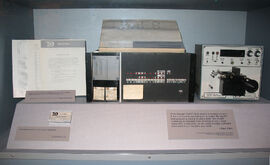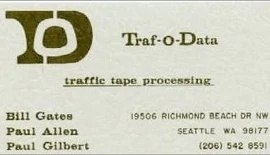Traf-O-Data was a business partnership between Bill Gates, Paul Allen and Paul Gilbert that existed in the 1970s. The objective was to read the raw data from roadway traffic counters and create reports for traffic engineers. The company had only modest success but the experience was instrumental in the creation of Microsoft Corporation a few years later.[1]
Traffic counting[]
State and local governments frequently perform traffic surveys with a pneumatic road tube traffic counter. Rubber hoses are stretched across a road and wheels of passing vehicles create air pulses that are recorded by a roadside counter. In the 1970s the counts were mechanically recorded on a roll of paper tape. The time and number of axles were punched as a 16-bit pattern into the paper tape. (The common Teletype paper tape uses only 8 bits.) Cities would hire private companies to translate the data into reports that traffic engineers could use to adjust traffic lights or improve roads.
Gates and Paul Allen were high school students at Lakeside School in Seattle. The Lakeside Programmers Group got free computer time on various computers in exchange for writing computer programs. Gates and Allen thought they could process the traffic data cheaper and faster than the local companies. They recruited classmates to manually read the hole-patterns in the paper tape and transcribe the data onto computer cards. Gates then used a computer at the University of Washington to produce the traffic flow charts. (Paul Allen's father was a librarian at UW.) This was the beginning of Traf-O-Data.[2]
Traf-O-Data hardware[]

Traf-O-Data 8008 computer with a tape reader.
The next step was to build a device to read the traffic tapes directly and eliminate the tedious manual work. The Intel 8008 microprocessor was announced in 1972 and they realized it could read the tapes and process the data. Allen had graduated and was enrolled at Washington State University. Since neither Gates nor Allen had any hardware design experience, they were initially stumped.

Traf-O-Data business card showing the names of Bill Gates, Paul Allen, and Paul Gilbert.
Gates and Allen had a friend, Paul Wennberg, who, like they, loitered at Control Data Corporation near the University of Washington, cadging open time on the mainframe computer. Wennberg, later the founder of the Triakis Corporation, was an electrical engineering student at the University of Washington. In the course of events Gates and Allen mentioned they were looking for somebody to build them a computer for free. They needed somebody good enough to build a computer from parts and the diagrams found in a computer magazine. Wennberg talked to his friend, Wes Prichard, who suggested to Wennberg that Gates and Allen head over to the UW Physics building, now known as Mary Gates Hall, to talk to Paul Gilbert, another electrical engineering student, who worked in the high-energy tracking laboratory. It was there that Paul Gilbert was approached by the duo to become a partner in Traf-O-Data.
That year Gilbert, piece by piece, wire-wrapped, soldered, and assembled from electrical components the working microcomputer.[3] Miles Gilbert, Paul Gilbert's brother, a graphic designer and draftsman, helped the fledgling company by designing the company's logo. Gates and Allen started writing the software. To test the software while the computer was being designed, Paul Allen wrote a computer program on WSU's IBM System/360 that would emulate the 8008 microprocessor.
Although the plan had been to manufacture and sell the machines, the State of Washington later offered free traffic processing services to cities, ending the need for private contractors, and all three principals moved on to other projects. The real contribution of Traf-O-Data was the experience that Gates and Allen gained, skills they used to write Altair BASIC for the MITS Altair 8800 computer.[4]
References[]
- ↑ "Traf-O-Data". New Mexico Museum of Natural History and Science. Archived from the original on March 23, 2012. Retrieved 2011-05-08.
- ↑ Wallace, James; Jim Erickson (1992). Hard Drive: Bill Gates and the Making of the Microsoft Empire. John Wiley & Sons. pp. 42–46. ISBN 0-471-56886-4.
- ↑ "Early Days as a Computer Programmer", October 27, 2011, thegatesnotes.com
- ↑ "Interview with Bill Gates and Paul Allen", October 1995, Fortune
External links[]
- Traf-O-Data at Wikipedia
|
Wikipedia (article: Traf-O-Data )
|
